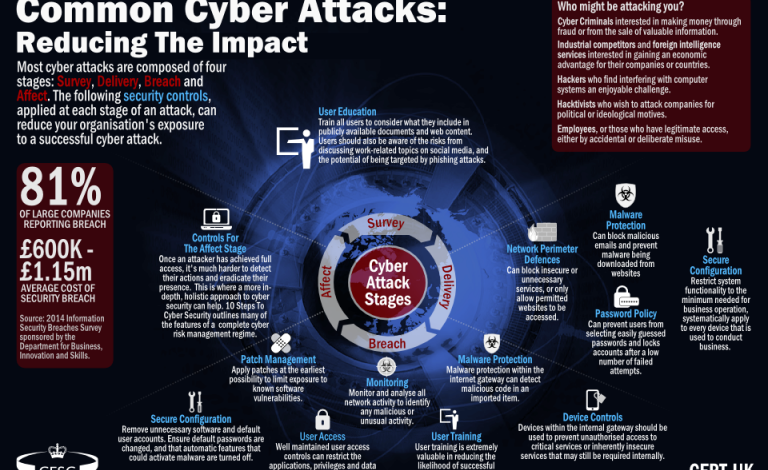
Most Common Cyber Attacks Explained
Most common cyber attacks are a serious threat in today’s digital world, impacting individuals and businesses alike. From the sneaky phishing email designed to steal your credentials to the devastating ransomware attack that locks your files, understanding these attacks is crucial for staying safe online. This post dives into the most prevalent threats, explaining how they work and what you can do to protect yourself.
We’ll explore everything from phishing and malware to denial-of-service attacks and social engineering, arming you with the knowledge to navigate the digital landscape more confidently.
We’ll break down each attack type, detailing the methods used, the potential consequences, and importantly, the preventative measures you can take. Whether you’re a tech-savvy individual or just starting to learn about cybersecurity, this guide offers practical advice and actionable steps to enhance your online security. Let’s get started!
Phishing Attacks
Phishing is a type of cyberattack where malicious actors attempt to trick individuals into revealing sensitive information, such as usernames, passwords, credit card details, or social security numbers. These attacks leverage social engineering techniques to manipulate victims into believing they are interacting with a legitimate entity. Understanding the various methods and characteristics of phishing attacks is crucial for effective prevention.Phishing Attack Types and MethodsDifferent types of phishing attacks employ various methods to deceive their targets.
Spear phishing, for example, targets specific individuals or organizations with personalized messages, increasing the likelihood of success. Whaling is a more sophisticated form of spear phishing, targeting high-profile individuals like CEOs or executives. Clone phishing involves sending emails that appear to be legitimate replies to previous communications, while pharming redirects users to fake websites without their knowledge.
Smishing utilizes SMS messages, and vishing uses voice calls to carry out the attack. Each method requires a different approach to detection and prevention.Common Characteristics of Phishing Emails and WebsitesPhishing emails and websites often share common characteristics that, if carefully examined, can reveal their malicious nature. These include poor grammar and spelling, suspicious links or attachments, urgent or threatening language, requests for personal information, and the use of generic greetings.
Legitimate organizations rarely request sensitive information via email or unexpected links. Furthermore, phishing websites often mimic the appearance of legitimate websites, but a closer inspection will often reveal discrepancies in the URL, security certificates, or overall design.Social Engineering Techniques in Phishing AttacksSocial engineering is the cornerstone of most phishing attacks. Attackers exploit human psychology by leveraging emotions such as fear, urgency, or greed to manipulate victims.
A common technique is to create a sense of urgency, implying that immediate action is required to avoid negative consequences. Another tactic is to build trust by impersonating a known entity, such as a bank or government agency. Manipulating the victim’s sense of curiosity, offering enticing rewards or threatening penalties, are all powerful tools used in successful phishing campaigns.
For example, an email claiming a large sum of money is waiting to be claimed, or a notification about an account being compromised, will prey on victims’ emotions.Comparison of Phishing Attack VectorsThe following table compares various phishing attack vectors, highlighting their success rates and prevention methods. Success rates are difficult to precisely quantify, as many attacks go unreported, but this table provides a general comparison based on observed trends.
| Attack Vector | Success Rate (Estimated) | Prevention Methods |
|---|---|---|
| High (15-30%) | Email authentication (SPF, DKIM, DMARC), spam filters, user education | |
| SMS (Smishing) | Medium (5-15%) | SMS filtering, user education, two-factor authentication |
| Social Media | Medium (10-20%) | Strong passwords, privacy settings, reporting suspicious accounts, user education |
| Phone (Vishing) | Low (2-5%) | Caller ID verification, caution with unsolicited calls, user education |
Malware Infections

Malware infections are a significant threat in today’s digital landscape, capable of causing data breaches, system failures, and substantial financial losses. Understanding the different types of malware, their distribution methods, and how to detect and remove them is crucial for protecting yourself and your data. This section will explore these key aspects of malware infections.
Types of Malware
Malware encompasses a broad range of malicious software designed to damage, disrupt, or gain unauthorized access to computer systems. Understanding the different categories is vital for effective prevention and remediation.
- Viruses: These are self-replicating programs that attach themselves to other files or programs, spreading infection as they execute. They often cause damage by corrupting files or slowing down system performance. A classic example is the “Melissa” virus, which spread through email attachments in the late 1990s.
- Worms: Unlike viruses, worms are self-contained programs that spread independently across networks, often exploiting vulnerabilities in systems to replicate and infect other devices. The “Conficker” worm, which affected millions of computers globally, is a notable example of a worm’s devastating potential.
- Trojans: These malicious programs disguise themselves as legitimate software, often luring users with attractive features or functionality. Once installed, they can perform various harmful actions, such as stealing data, installing other malware, or granting remote access to attackers. A Trojan might appear as a game download that secretly installs keyloggers.
- Ransomware: This type of malware encrypts a user’s files, rendering them inaccessible until a ransom is paid. Ransomware attacks have become increasingly sophisticated, targeting individuals and organizations alike. The WannaCry ransomware attack in 2017 crippled hospitals and businesses worldwide.
- Spyware: This malware secretly monitors a user’s activities, collecting sensitive information such as passwords, credit card details, and browsing history. This information is often sent to the attacker without the user’s knowledge. Spyware can be installed through malicious websites or bundled with other software.
Malware Distribution Methods
Malware is spread through various channels, making it essential to practice caution online.
- Email Attachments: Malicious attachments, often disguised as invoices, documents, or other seemingly innocuous files, can deliver malware directly to a user’s computer. Opening these attachments can trigger the execution of malicious code.
- Malicious Websites: Visiting compromised websites or clicking on malicious links can download malware onto a user’s system. These websites may be disguised as legitimate sites, or they may be part of a phishing campaign.
- Software Vulnerabilities: Outdated or vulnerable software can provide an entry point for attackers to install malware. Regular software updates and patching are crucial to mitigating this risk.
- Drive-by Downloads: These occur when malware is automatically downloaded to a user’s system simply by visiting a compromised website, without any explicit action from the user. This often happens through exploits targeting vulnerabilities in web browsers or plugins.
Indicators of Malware Infection
Several signs can indicate a malware infection. Recognizing these indicators is crucial for prompt action.
- Slow System Performance: Unexpected slowdowns or crashes can be a sign of malware consuming system resources.
- Unusual Pop-up Messages: Frequent or unexpected pop-up messages, especially those related to security warnings or software updates, may indicate a malware infection.
- Unauthorized Software Installations: The appearance of unknown programs or applications on your system can suggest a malware infection.
- Changes in Browser Settings: Unexpected changes to your browser’s homepage, search engine, or other settings can be a warning sign.
- Data Loss or Corruption: Missing or corrupted files can be a symptom of a malware infection.
Malware Removal Procedure
Removing malware requires a systematic approach.
- Disconnect from the Internet: This prevents the malware from spreading or communicating with the attacker.
- Boot into Safe Mode: This starts your computer with minimal programs, limiting the malware’s ability to run.
- Run a Malware Scan: Use a reputable antivirus or anti-malware program to scan your system for malware.
- Remove Detected Malware: Follow the instructions provided by the malware scanner to remove the detected threats.
- Restore System Files: If necessary, restore any corrupted or deleted files from backups.
- Update Software: Ensure that your operating system and all software are up-to-date with the latest security patches.
- Change Passwords: Change all your passwords, especially those for online accounts.
Malware Impact Categorization
The impact of malware can vary significantly.
- Data Breach: Spyware, Trojans, and ransomware can all lead to data breaches, resulting in the theft of sensitive personal or financial information. The Equifax data breach in 2017, which exposed the personal information of millions of people, is a stark example of the consequences of a data breach.
- System Failure: Viruses, worms, and ransomware can cause system failures, rendering computers unusable. The NotPetya ransomware attack in 2017 caused significant disruptions to businesses worldwide.
- Financial Loss: Ransomware attacks can lead to significant financial losses due to ransom payments and the cost of recovery. Additionally, data breaches can result in financial losses due to identity theft and fraud.
Denial-of-Service (DoS) Attacks
Denial-of-Service (DoS) attacks are a significant threat to online services, aiming to disrupt normal traffic by flooding a target with illegitimate requests. These attacks render websites, servers, and other online resources inaccessible to legitimate users, causing significant financial and reputational damage. Understanding the various types of DoS attacks and their mitigation strategies is crucial for maintaining online stability and security.DoS attacks disrupt network services by overwhelming the target’s resources, preventing it from responding to legitimate requests.
This can manifest in various ways, from slow website loading times to complete unavailability. The impact on availability depends on the severity and duration of the attack, potentially affecting business operations, customer satisfaction, and even public safety in critical infrastructure scenarios.
Types of Denial-of-Service Attacks
DoS attacks are categorized based on their methods and targets. Understanding these categories helps in implementing appropriate defense mechanisms.
- Volumetric Attacks: These attacks flood the target with massive amounts of traffic, consuming bandwidth and overwhelming network infrastructure. Examples include UDP floods, ICMP floods (ping floods), and NTP amplification attacks, which exploit vulnerabilities in network time protocol servers to magnify the attack’s impact.
- Protocol Attacks: These attacks exploit vulnerabilities in network protocols to disrupt communication. SYN floods, for instance, exploit the TCP three-way handshake to exhaust server resources by sending numerous SYN requests without completing the connection. Other examples include Smurf attacks and Land attacks, which utilize ICMP and TCP respectively to overload the target.
- Application Layer Attacks: These attacks target specific applications or services running on the server. HTTP floods, for example, send a large number of HTTP requests to overwhelm the web server. Other examples include Slowloris attacks, which slowly consume server resources by keeping connections open, and attacks that exploit vulnerabilities in specific application protocols like those targeting specific databases or web applications.
Distributed Denial-of-Service (DDoS) Attacks
DDoS attacks differ from traditional DoS attacks by utilizing a network of compromised computers (botnets) to launch the attack. This distributed nature makes them significantly more powerful and difficult to mitigate. A single attacker can overwhelm a target with a massive amount of traffic from numerous sources, making it much harder to identify and block the attack traffic. The sheer scale of a DDoS attack can easily overwhelm even the most robust network infrastructure, leading to prolonged outages.
Unlike traditional DoS attacks originating from a single source, tracing the origin of a DDoS attack is significantly more complex.
Mitigation Techniques for DoS Attacks
Effective mitigation requires a multi-layered approach combining various techniques.
- Rate Limiting: This technique restricts the number of requests from a single IP address or network within a specific time frame. This helps to filter out illegitimate traffic while allowing legitimate users to access the service.
- Intrusion Detection and Prevention Systems (IDPS): These systems monitor network traffic for malicious activity and can automatically block or mitigate attacks. They utilize signature-based and anomaly-based detection to identify and respond to various types of DoS attacks.
- Content Delivery Networks (CDNs): CDNs distribute traffic across multiple servers, reducing the load on any single server and making it more resistant to attacks. They act as a buffer, absorbing much of the attack traffic before it reaches the origin server.
- Blackholing: This involves routing attack traffic to a “black hole,” effectively dropping it without any response. This is a last resort, as it can also block legitimate traffic. It’s often used for large-scale volumetric attacks.
- Traffic Filtering: This involves using firewalls and other network devices to filter out known attack patterns and traffic from suspicious sources. This requires careful configuration to avoid blocking legitimate traffic.
SQL Injection Attacks
SQL injection is a sneaky type of attack that leverages vulnerabilities in poorly designed database interactions within web applications. Attackers exploit these flaws to inject malicious SQL code into input fields, manipulating the database’s behavior to their advantage. This can range from simply retrieving sensitive data to completely compromising the entire system. Understanding the mechanics and prevention methods is crucial for securing web applications.
SQL Injection Mechanisms and Database Exploitation
SQL injection attacks work by taking advantage of how web applications handle user inputs. If an application doesn’t properly sanitize or validate user-supplied data before incorporating it into SQL queries, an attacker can inject malicious SQL code. This injected code is then executed by the database server, potentially granting the attacker unauthorized access or control. For example, an attacker might inject code designed to bypass authentication, retrieve all user data, or even modify or delete database records.
The core problem lies in the failure to separate user input from the application’s SQL logic.
Common Vulnerabilities Leading to SQL Injection
Several common vulnerabilities make applications susceptible to SQL injection attacks. Improper input validation is a primary culprit. Failing to check the type, length, and format of user input allows attackers to easily inject malicious code. Another key vulnerability is the use of dynamic SQL queries without proper parameterization. When an application directly concatenates user input into SQL queries, it creates an opening for attackers to inject commands.
Finally, a lack of stored procedure usage can increase vulnerability. Stored procedures offer a layer of protection by pre-compiling and parameterizing SQL code, mitigating the risks associated with directly embedding user input.
Preventing SQL Injection Attacks
Preventing SQL injection requires a multi-pronged approach focused on secure coding practices and robust input validation. Parameterized queries (or prepared statements) are the cornerstone of SQL injection prevention. These treat user input as data, not as executable code, effectively neutralizing any malicious intent. Input validation should be comprehensive, checking not only data types but also length, format, and content.
Using a whitelist approach, where only allowed characters and patterns are accepted, is far more secure than a blacklist approach that tries to block everything deemed “bad”. Furthermore, employing an output encoding mechanism to prevent reflected or stored XSS attacks alongside the SQL injection protection adds another layer of security. Finally, regularly updating database software and web application frameworks patches known vulnerabilities, reducing the attack surface.
Vulnerable and Secure Code Examples
The following table demonstrates examples of vulnerable code and their secure alternatives.
| Vulnerable Code | Secure Code | Explanation of the fix | Attack Vector |
|---|---|---|---|
string query = "SELECT
|
string query = "SELECTFROM users WHERE username = @username AND password = @password"; |
Using parameterized queries prevents direct injection of user input into the SQL statement. The database treats the parameters as data, not code. | An attacker could inject SQL code into the username or password fields to bypass authentication or retrieve data. |
string query = "UPDATE products SET price = " + newPrice + " WHERE id = " + productId; |
string query = "UPDATE products SET price = @newPrice WHERE id = @productId"; |
Parameterization protects against SQL injection when updating data. | An attacker could manipulate the newPrice or productId values to alter data or perform unauthorized actions. |
string query = "SELECT
|
string query = "SELECTFROM users WHERE id IN (@userIds)"; |
Proper handling of comma-separated lists within SQL queries is crucial to prevent injection. | An attacker could inject additional IDs or malicious SQL code into the userIds string. This example requires more sophisticated handling of the parameter array. A better solution might involve a stored procedure or a different approach to managing the list of IDs.
|
Man-in-the-Middle (MitM) Attacks
Man-in-the-middle (MitM) attacks are a serious threat to online security, allowing attackers to secretly intercept communication between two parties who believe they are directly interacting. This interception allows the attacker to eavesdrop, modify, or even completely fabricate the communication, leading to significant consequences for both individuals and organizations. Understanding how these attacks work and implementing preventative measures is crucial for maintaining online privacy and data integrity.MitM attacks function by positioning an attacker between two communicating parties.
The attacker intercepts the communication, potentially modifying it before forwarding it to the intended recipient. This can be achieved through various techniques, including ARP poisoning (on local networks), DNS spoofing (redirecting users to malicious websites), rogue Wi-Fi hotspots (luring users to insecure networks), and SSL stripping (downgrading secure connections to insecure ones). The attacker essentially becomes the intermediary, unbeknownst to the legitimate users.
MitM Attack Techniques
Several methods are employed to execute MitM attacks. ARP poisoning, for instance, involves sending false ARP (Address Resolution Protocol) messages to associate the attacker’s MAC address with the IP address of a legitimate device on a local network. This allows the attacker to intercept all traffic destined for that device. DNS spoofing, on the other hand, manipulates DNS responses to redirect users to malicious websites, even if the user types in the correct URL.
Rogue Wi-Fi hotspots, often disguised as legitimate networks, trick users into connecting to an insecure network controlled by the attacker. Finally, SSL stripping downgrades HTTPS connections to HTTP, allowing the attacker to intercept unencrypted data.
Consequences of Successful MitM Attacks
The consequences of a successful MitM attack can be severe. Data breaches are a primary concern, with sensitive information like login credentials, credit card details, and personal communications falling into the wrong hands. Financial losses can result from unauthorized transactions or fraudulent activities. Furthermore, MitM attacks can be used to install malware on the victim’s devices, leading to further compromise and potential long-term damage.
The reputation of an organization can also suffer significantly if a MitM attack leads to a data breach or disruption of services.
Examples of Real-World MitM Attacks
Numerous real-world examples illustrate the impact of MitM attacks. The infamous “Great Firewall of China” utilizes techniques reminiscent of MitM attacks to censor internet traffic within the country. While not strictly malicious in intent, it demonstrates the potential for large-scale interception and manipulation of online communication. In the past, less sophisticated attacks have targeted individuals using public Wi-Fi, allowing attackers to steal login credentials or credit card information.
The impact of such attacks can range from minor inconvenience to severe financial loss, depending on the compromised data.
Detecting and Preventing MitM Attacks
Detecting and preventing MitM attacks requires a multi-layered approach. The use of encryption, particularly HTTPS, is crucial for securing online communication. Verifying the authenticity of websites using SSL certificates helps prevent users from connecting to malicious sites. Virtual Private Networks (VPNs) encrypt traffic between the user’s device and the VPN server, providing an additional layer of protection against MitM attacks, especially when using public Wi-Fi.
Regular software updates and the use of strong passwords further enhance security. Finally, being vigilant about suspicious websites and network connections can help individuals avoid falling victim to these attacks.
Password Attacks
Password attacks are a significant threat in the digital landscape, exploiting vulnerabilities in password security to gain unauthorized access to systems and data. These attacks leverage various techniques to crack passwords, ranging from simple guessing to sophisticated automated methods. Understanding these methods is crucial for implementing robust security measures.Password attacks often target weak or easily guessable passwords, highlighting the critical need for strong password policies and multi-factor authentication.
The consequences of a successful password attack can be devastating, leading to data breaches, financial losses, and reputational damage. Therefore, proactive measures to enhance password security are essential for both individuals and organizations.
Brute-Force, Dictionary, and Rainbow Table Attacks
These are common methods used to crack passwords. A brute-force attack tries every possible combination of characters until the correct password is found. This is computationally intensive but effective against weak passwords. Dictionary attacks use a list of common words and phrases to guess passwords, exploiting the tendency of users to choose easily guessable passwords. Rainbow table attacks pre-compute hashes of common passwords, significantly speeding up the cracking process.
The effectiveness of these attacks is directly proportional to the strength of the password and the resources available to the attacker. For example, a short, easily guessable password might be cracked within seconds using a dictionary attack, while a strong, complex password could take significantly longer, or even be uncrackable within a reasonable timeframe using a brute-force attack.
Strong Password Policies and Multi-Factor Authentication
Implementing strong password policies is vital in mitigating password attacks. These policies should mandate minimum password length, complexity requirements (including uppercase, lowercase, numbers, and symbols), and regular password changes. Furthermore, multi-factor authentication (MFA) adds an extra layer of security by requiring multiple forms of authentication, such as a password and a one-time code from a mobile app. MFA significantly reduces the risk of unauthorized access even if a password is compromised.
For instance, even if an attacker obtains a user’s password through phishing, they would still need access to the user’s phone or other MFA device to gain access to the account.
Password Security Best Practices
Employing robust password security best practices is crucial for protecting against password attacks. Users should avoid using easily guessable passwords such as names, birthdays, or common words. They should also refrain from reusing passwords across multiple accounts. Password managers can assist in generating and securely storing complex passwords, alleviating the burden on users to remember numerous strong passwords.
Regular security audits and employee training on password security best practices are also essential for organizations.
Characteristics of a Strong Password
A strong password is essential to defend against various attack methods. Here’s a list of characteristics that define a strong password:
- Length: At least 12 characters long.
- Complexity: Includes a mix of uppercase and lowercase letters, numbers, and symbols.
- Uniqueness: Different from passwords used for other accounts.
- Regular Updates: Changed periodically.
- Avoidance of Personal Information: Does not contain personal data like names, birthdays, or addresses.
Social Engineering Attacks

Social engineering attacks exploit human psychology to manipulate individuals into divulging confidential information or performing actions that compromise security. Unlike technical attacks that target system vulnerabilities, social engineering leverages trust and human error. These attacks are incredibly effective because they bypass traditional security measures, relying instead on the weakest link in any security system: the human being.
Social engineering techniques are diverse and constantly evolving, adapting to new technologies and societal trends. They often involve a combination of deception, manipulation, and persuasion to achieve their goals. Understanding these techniques is crucial for developing effective defenses.
Pretexting, Most common cyber attacks
Pretexting involves creating a believable scenario or false pretense to gain access to information or resources. Attackers often impersonate legitimate individuals or organizations, crafting convincing stories to elicit the desired response. For example, an attacker might pose as a bank employee calling to verify account information, or as a tech support representative needing remote access to a computer. The success of pretexting relies on the attacker’s ability to build rapport and exploit the victim’s trust.
A sophisticated pretexting attack might involve extensive research on the target, gathering information from social media or other public sources to personalize the interaction and increase its credibility.
Baiting
Baiting is a simpler, more direct approach that uses a lure to entice the victim. This lure can be anything from a seemingly harmless email attachment containing malware to a promise of a free gift or a significant discount. The attacker exploits the victim’s curiosity or greed, prompting them to click a malicious link, download a compromised file, or reveal sensitive information.
An example of baiting is an email promising a free gift card in exchange for completing a short survey, which actually leads to a phishing website. The effectiveness of baiting lies in its simplicity and the appeal of the offered reward.
Quid Pro Quo
Quid pro quo, meaning “something for something,” involves offering a service or favor in exchange for information or access. This technique often targets employees or individuals with access to sensitive data. An attacker might offer to help with a task or provide technical assistance in exchange for login credentials or access to a system. For instance, an attacker might pretend to be an IT consultant offering to fix a computer problem, then subtly request administrative access during the “repair” process.
The success of this technique relies on the victim’s willingness to reciprocate and their lack of awareness of the attacker’s true intentions.
Tailgating
Tailgating exploits the human tendency to hold doors open for others. In a physical security context, an attacker simply follows closely behind an authorized individual as they enter a restricted area, bypassing security measures like access cards or security checkpoints. This technique is particularly effective in busy environments where security personnel may not be able to monitor every individual closely.
Imagine a scenario where an attacker observes an employee swiping their access card and immediately follows them through the door before it closes. The attacker gains unauthorized access without needing to breach any technical security systems.
Psychological Principles Behind Social Engineering
Social engineering exploits several key psychological principles. Reciprocity, the tendency to return favors, is often leveraged in quid pro quo attacks. Authority, the deference to those perceived as being in positions of power, is exploited when attackers impersonate figures of authority. Scarcity, the increased desirability of items or opportunities perceived as limited, is used to create urgency and pressure.
Social proof, the influence of others’ actions, can be manipulated to make victims believe that others have already taken the desired action. Finally, liking, the tendency to comply with requests from people we like or trust, is a cornerstone of most social engineering techniques.
Social Engineering Training Program
A comprehensive training program should educate users on the various social engineering tactics and equip them with the skills to identify and respond to these attacks. The program should include:
• Awareness training: Educate users about the different social engineering techniques and how they work.
• Scenario-based training: Present users with realistic scenarios to help them practice identifying and responding to social engineering attempts.
• Phishing simulations: Conduct simulated phishing attacks to test users’ ability to identify malicious emails and websites.
• Security awareness best practices: Reinforce good security habits, such as verifying requests, being cautious of unsolicited communication, and reporting suspicious activity.
• Regular updates: Keep training materials current to reflect the latest social engineering tactics.
Summary: Most Common Cyber Attacks

In conclusion, staying ahead of cyber threats requires a multi-faceted approach. Understanding the most common cyber attacks – from phishing and malware to denial-of-service and social engineering – is the first step. By implementing strong passwords, practicing safe browsing habits, and staying updated on the latest security best practices, you significantly reduce your vulnerability. Remember, vigilance and proactive security measures are your best defense against the ever-evolving landscape of cybercrime.
Stay informed, stay protected!
Query Resolution
What is the difference between a virus and a worm?
A virus needs a host program to spread, while a worm can replicate itself independently across networks.
How can I spot a phishing email?
Look for poor grammar, suspicious links, urgent requests for information, and emails from unknown senders. Always verify the sender’s identity before clicking any links or providing personal information.
What is two-factor authentication (2FA), and why is it important?
2FA adds an extra layer of security by requiring a second form of verification, like a code from your phone, in addition to your password. This makes it much harder for attackers to access your accounts, even if they steal your password.
What should I do if I think my computer is infected with malware?
Disconnect from the internet immediately. Run a full scan with reputable antivirus software. If the infection persists, seek professional help from a cybersecurity expert.
Are VPNs effective against all cyber attacks?
VPNs are excellent for protecting your data during transit and masking your IP address, offering protection against Man-in-the-Middle attacks and some forms of surveillance. However, they don’t offer complete protection against all types of cyberattacks, such as malware infections targeting your local system.





